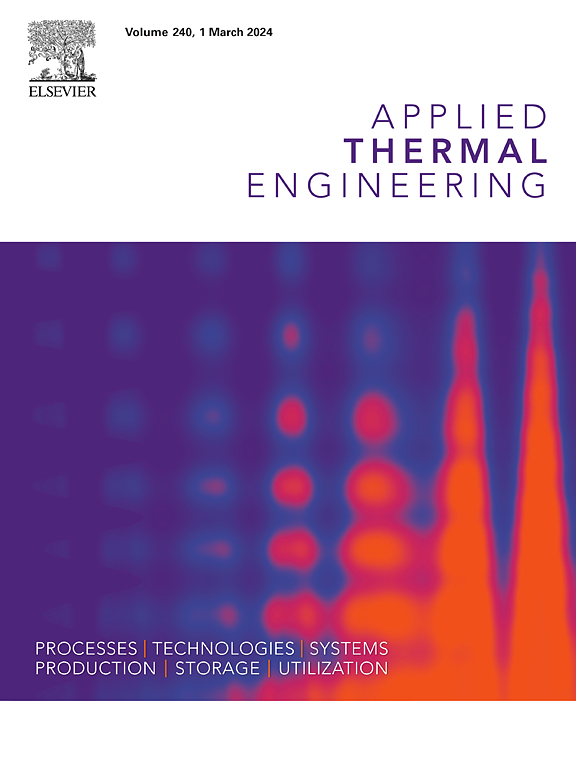Performance characteristics of optimized bi-fluid photovoltaic-thermal solar system: A comparative study of innovative cooling system made of different materials
IF 6.9
2区 工程技术
Q2 ENERGY & FUELS
引用次数: 0
Abstract
High ambient temperatures reduce the efficiency and lifespan of PV solar systems due to cell overheating. Solar PV cooling can prevent this and improve performance, especially in hot regions. This work attempts to develop a novel, economic, and efficient bi-fluid cooling technology to reduce temperature rise and enhance the overall energy output of hybrid PVT systems. The proposed bi-fluid cooling system involves the use of an absorber plate integrated with a locally available wire-on-tube (serpentine-shaped tube) heat exchanger mounted on the back side of the PVT system for cooling water flow. The heat exchanger is also equipped with air passages for air circulation and natural convection cooling. This type of heat exchanger, which uses bi-fluid cooling technique, can significantly enhance the heat dissipation generated by the solar PV cells, improving the overall performance of the system. Three identical cooling systems made of copper (PVT-Cu), aluminum (PVT-Al), and stainless steel (PVT-Steel) were proposed, studied, and compared to achieve optimal system performance. A life cycle cost analysis (LCCA) was also performed, and the data obtained were compared with those of a conventional PV-standard system to evaluate the feasibility and annual performance of the systems. The developed 3D numerical model of the PVT systems integrated with the proposed bi-fluid cooling systems was simulated using Ansys Fluent 2024. The developed numerical model was also validated with experimental data from the previous study. Results showed that the improvement in the average surface temperatures of the proposed PVT-Steel, PVT-Al and PVT-Cu systems was 1.62, 2.61, and 5.27 %. The average daily increase in electrical output of the proposed PVT-Steel, PVT-Al, and PVT-Cu systems was 7.66 %, 13.51 %, and 16.04 % higher. The improvement in electrical efficiency when using the proposed PVT-Steel, PVT-Al, and PVT-Cu systems was approximately 9.14 %, 15.20 %, and 17.93 %, respectively. The lowest levelized cost of energy (LCOE) was achieved by the proposed PVT-Cu system at $0.47 per kWh, followed by PVT-Al ($0.49 per kWh), and finally with PVT-Steel ($0.52 per kWh). The payback time of the three proposed PVT-Cu, PVT-Al, and PVT-Steel systems was reduced by 78.78 %, 59.96 %, and 40.89 %, respectively.
优化双流体光伏-热太阳能系统的性能特征:不同材料创新冷却系统的比较研究
由于电池过热,高环境温度降低了光伏太阳能系统的效率和寿命。太阳能光伏冷却可以防止这种情况并提高性能,特别是在炎热地区。这项工作旨在开发一种新颖、经济、高效的双流体冷却技术,以降低温度升高,提高混合动力PVT系统的整体能量输出。拟议的双流体冷却系统包括使用吸收板和安装在PVT系统背面的当地可用的管上导线(蛇形管)热交换器,用于冷却水流动。换热器还配有空气通道,用于空气循环和自然对流冷却。这种换热器采用双流体冷却技术,可以显著增强太阳能光伏电池的散热能力,提高系统的整体性能。提出了三种相同的由铜(PVT-Cu)、铝(PVT-Al)和不锈钢(PVT-Steel)制成的冷却系统,并对其进行了研究和比较,以达到最佳的系统性能。并进行了全生命周期成本分析(LCCA),并将所得数据与传统光伏标准系统进行了比较,以评估系统的可行性和年度绩效。利用Ansys Fluent 2024对集成双流体冷却系统的PVT系统进行了三维数值模拟。本文所建立的数值模型也得到了实验数据的验证。结果表明,PVT-Steel、PVT-Al和PVT-Cu体系的平均表面温度分别提高了1.62%、2.61%和5.27%。PVT-Steel、PVT-Al和PVT-Cu系统的电力输出平均日增幅分别为7.66%、13.51%和16.04%。当使用PVT-Steel、PVT-Al和PVT-Cu系统时,电效率的提高分别约为9.14%、15.20%和17.93%。PVT-Cu系统实现了最低的能源成本(LCOE),为每千瓦时0.47美元,其次是PVT-Al(每千瓦时0.49美元),最后是PVT-Steel(每千瓦时0.52美元)。PVT-Cu、PVT-Al和PVT-Steel体系的投资回收期分别缩短了78.78%、59.96%和40.89%。
本文章由计算机程序翻译,如有差异,请以英文原文为准。
求助全文
约1分钟内获得全文
求助全文
来源期刊

Applied Thermal Engineering
工程技术-工程:机械
CiteScore
11.30
自引率
15.60%
发文量
1474
审稿时长
57 days
期刊介绍:
Applied Thermal Engineering disseminates novel research related to the design, development and demonstration of components, devices, equipment, technologies and systems involving thermal processes for the production, storage, utilization and conservation of energy, with a focus on engineering application.
The journal publishes high-quality and high-impact Original Research Articles, Review Articles, Short Communications and Letters to the Editor on cutting-edge innovations in research, and recent advances or issues of interest to the thermal engineering community.
 求助内容:
求助内容: 应助结果提醒方式:
应助结果提醒方式:


